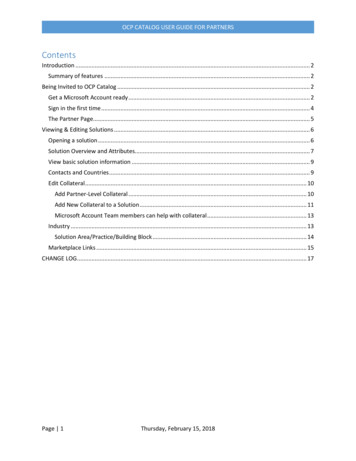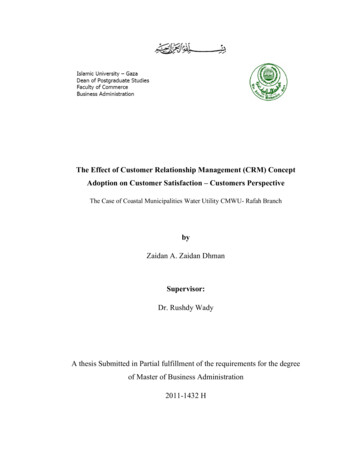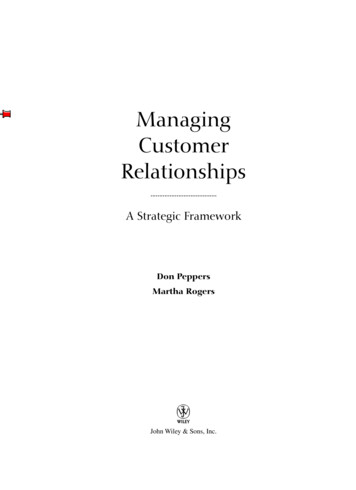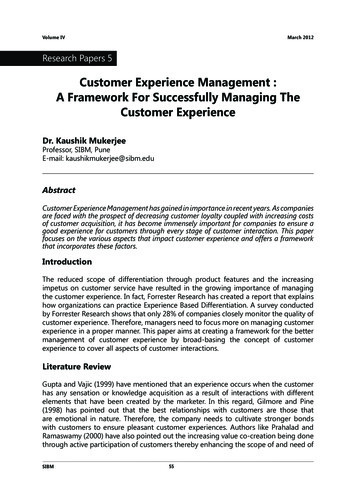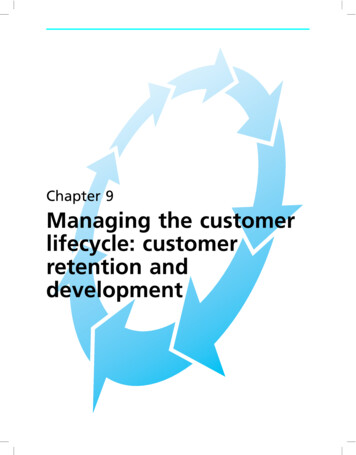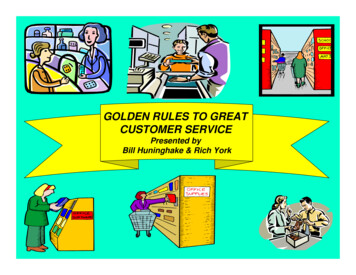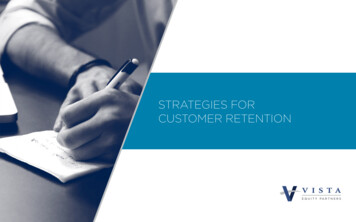
Transcription
A STUDY ON CUSTOMER’S ATTITUDE AND PERCEPTION TOWARDSDIGITAL FOOD APP SERVICESDr. Neha Parashar1 Ms. Sakina Ghadiyali2ABSTRACTServices are intangible products where in there cannot be any transfer of possession or ownership, and theycannot be sold but come into existence at the time they are consumed or bought. Services cannot be stored ortransported. Eg: accounting, banking, cleaning, consultancy, education, etc.Digital services on the other hand are services that are anything that can be delivered through aninformation infrastructure such as the internet, in various forms i.e. applications, web pages, social media,etc. In the paper the major focus will be on the various apps that are available either by 3 rd party for deliverypurpose or by restaurants themselves for various purposes like delivery, pointing system, in house appordering, etc.Consumer behavior is the study of how individual customers, groups or organizations select, buy, use, anddispose ideas, goods, and services to satisfy their needs and wants. It refers to the actions of the consumers inthe marketplace and the underlying motives for those actions.From this research paper we would understand the shift of consumer’s behaviors with the introduction oftechnology and what are the different kinds of applications that consumers are satisfied with and whatmakes them happy and satisfied about the service.The main objective of the paper is to understand the relation between facilities and the purchase behavior.Secondly to find the most popular app in the food delivery industry and understand as to how havetechnology played an important role in the restaurant industry.Keywords: Consumer behavior, Food delivery app, zomato, fasso, e-commerce,INTRODUCTIONIn today’s world service sector contributes64.80% in GDP. Zomato is one of the mostpopular applications that provide services tothe user to discover restaurants. The rise ofdigital technology is reshaping theindustries. With the increased use oftechnology, the number of people engaginginto the digital sector are rapidly increasing.Even Consumers are accustomed toshopping or even ordering online throughappsorwebsites,withmaximumconvenience and transparency, expecting thesame experience that they would get fromthe outlet itself. To match up with theconsumer’s expectations apps are providingincreased facilities and services to the1. Faculty (Finance), IBS Business School,Pune2. Student, IBS Business School, Punecustomers. This scenario doesn’t exist only inone country but all across the globe. Being upto date with the customers’ expectationshelps firm retain customer’s to a greaterextent. The Figure 1 below shows the averageretention of customers with the help ofproviding various kinds of facilities to thecustomers.Figure 1: Retention of Customers with theHelp of Digital TechnologySource: http://www.mckinsey.com
Digital technology has just started growing, itwill continue to grow at a rapid rate and withthe effect of this so will the various otherindustries, including the food deliveryindustry. In the below figure we can see thatthe usage of online portals have beenconstantly increasing and they are expected toincrease at a rapid rate even in the near future.Our research indicates that online penetrationof the total food-delivery market broke 30percent in 2016. It is also believed that thepenetration rates will grow further as themarket matures, eventually reaching 65percent per year. As per another research theperceptions of the user regarding the servicequality of ZOMATO is less than hisexpectations of what an excellent serviceshould be. So, ZOMATO cannot be categorizedan excellent service provider as per theresponses we have received from the users.Figure 2: Expected Growth of online andoffline industry Facebook ordering.Tabletop e-waiter & checkout.Digital menu boards smartphones.Games while-u-wait.Online coupons.Indian Food App ScenarioWith all the boom in digital industry acrossthe globe, it’s had its impact on the Indianeconomy too. The online food ordering firmshave sprouted up in bulk. The market size offood in India is expected to reach Rs. 42 lakhcrore by 2020, reports BCG. Presently, theIndian food market is around 350 billion.The space is coming up with a lot ofinnovation catering to their customerconvenience, satisfaction and retention. Thishas also built room for a lot of new players,who are targeting specific groups of people.Many new players joining the segment withinnovative business models such asdelivering food for health conscious people,home cooked meals, etc.Food tech is the hot talk in the startup town.After technology startups have made theirmark in the e-commerce, taxi & real estatesectors, now the ever-hungry Indian entrepreneurs are looking to satiate the appetite ofothers. Food tech is a vast market and fooddelivery startups are just a part of it.http://www.mckinsey.comThe recent innovations in the global marketare: Mobile ordering.iPad order kiosks.Various apps in the Indian market are: Food Panda Zomato Swiggy Box8 Fasoos Fast food delivery appsFigure3: The various food apps available in IndiaServices ProvidedAppsOriginatedDeliveryOnline MenuExpandedFood PandaSingaporeYesYes12000 RestaurantsZomatoPortugalYesYes10000 RestaurantsBeer CaféIndiaNoYes33 RestaurantsBox8IndiaYesYes60 StoresFasoosIndiaYesYes125 CentersDominosIndiaYesYes800 outletsJust EatDenmarkYesYes2000 RestaurantsSwiggyIndiaYesYes5000 RestaurantsPizza Hut DeliveryUSYesYes1300 OutletsFasoosIndiaYesYes200 StoresSource: Author created with the help of secondary dataDelivery ChargesYesNoNoYesNoNoNoYesNoNo
LITERATURE REVIEWA research on the changing market for fooddelivery (Carsten Hirschberg et al 2016)indicates that online’s penetration of the totalfood-delivery market broke 30 percent in2016. We believe penetration rates will growfurther as the market matures, eventuallyreaching 65 percent per year.According to gloria food the advantage ofonline ordering and the reasons for thegrowth of food delivery app industry areConvenience, Simpler menu to manage,significant savings, no hassels etcFoodPanda is an introduction to the newestfood sensation that’s here to stay (ShiyinChan , 2015) Foodpanda is a global onlinefood delivery marketplace headquartered inBerlin, Germany. Fun fact - they’re alsoknown as hellofood in other places in theworld.Bhavna Singh (2015) said that Foodpandahas been present in the Indian market sinceMay 2012. Foodpanda first major move wasacquisition of TastyKhana, which waslaunched in the city of Pune in 2007.Together with TastyKhana and JUST EAT, itis now present in over 200 cities and partnerswith over 12,000 restaurants.She also talked about JUST EAT waslaunched in Denmark in 2001 and was tradedpublicly on the London Stock Exchange.Their Indian business was launched asHungry Bangalore in 2006. It was renamed in2011 when JUST EAT acquired a majorityshare in the business. Today, the companypartners with over 2,000 restaurants.According to Deepinder Goyal, Zomato CEOand co-founder told TechCrunch that heexpects to reach 10,000 restaurants in India ina few months. “We have a sales team ofaround 300 in India and 5,000-oddadvertisers these partners know thevolume we bring to them so it is quite easyfor us to launch this new service.”According to a recent sectoral reportpublished by IBEF (Indian Brand EquityFoundation), food has been one of the largestsegments in India’s retail sector, valued at 490 billion in 2013. The Indian food retailmarket is expected to reach Rs 61 lakh crore( 894.98 billion) by 2020. The Indian foodprocessing industry accounts for 32 percentof the country’s total food market, one of thelargest industries in India and ranked fifth interms of production, consumption, exportand expected growth. The online foodordering business in India is in its nascentstage, but witnessing exponential growth.The organised food business in India isworth 48 billion, of which food delivery isvalued at 15 billion. Investment in foodstartups, which mainly include food orderingapps, has increased by 93 percent to 130.3million, comprising 17 deals till September2015, as against only five deals in 2014.According to a January 28 report in TheTimes of India, Rocket Internet backedFoodpanda has not found a buyer even witha rock bottom price tag of 10-15 million.Thecompany laid off 300 people in December2015, about 15% of its workforce. InSeptember 2015, TinyOwl had fired 100employees in its Mumbai and Pune offices.And in October, Zomato sacked 300 workers.UK based Just Eat entered and exited themarket faster than you would order andreceive pizza.RESEARCH METHODOLOGYObjectives To analyse factors affecting attitude ofcustomers regarding food delivery appsTo find the most popular app in thedigital food delivery appTo analyze the relationship between fooddelivery aap and the facilities providedby the same.DATA COLLECTION AND ANALYSISThe data has been collected by both ieprimary and secondary sources. Primarydata includes information collected throughquestionnaire based on attitude andperception of customers using food deliveryapps in India. Secondary data includedcollecting information about various apps,the industry position, etc from the various
portals from the internet, journals, magzinesetcSample sizeThe total sample size was 129 respondents,out of which a major portion was Gen Z i.e.people of the age group 20-25 years.Table 4: Demographic profileCategoryGenderFollowing research tools were used to doanalyses and to draw conclusionsCronbach alphaChi squareWeighted averageDescriptive analysisHo: There is no significant relationshipbetween factors affecting usage and thefood appsH1: There is a significant relationshipbetween factors affecting usage and thefood apps Ho: There is no association of popularitywith the awareness methods used.H1: There is association of popularity ofan app with the awareness methodsused. Ho: There is no most popular app forfood delivery among samplesH1: There is a most popular app for fooddelivery among samplesANALYSIS AND INTERPRETATIONTo understand the behavior of customersregarding usage of food delivery apps, socioeconomic characteristics of the customerswere studied. They are the importantvariables as they decide the consumptionpattern and customer behavior regardingthese apps. Generally it is believed that, asthe income, age and education of thecustomer varies impact the usage pattern ofmobile apps. The following table 4 representsthe socio-economic pattern of the 25yrs25-30 yrs30-35 yrs35 and rkingSelf 000-170000170000-250000Above 250000TOTAL6125141911951%21%12%16%100%Less than 10001000-17501750-25002500-4000More than THESIS PercentageAgeResearch Tools NumberIncomeConsumptionSource: Author with the help of primary dataSpecific Information Relating to CustomerBehaviorThe responses of the customer about theusage and the factors affecting usage weretabulated and analyzed to understand theirbehavior.A. Frequency of usage of Food DeliveryappsThe Table 5 below shows the usage ofdifferent food delivery apps among theselected samples. As per the data collectedwe can analyze that food panda and fast fooddelivery app are among the most preferredfood apps by consumers followed by Swiggyand Zomato.
Table 5: Usage of apps as per the respondentsAPPSFoodPandaZomatoSwiggyBox8FasoosFast food delivery appsOthersUSAGE72%62%65%47%58%76%8%An examination of data reveals that beingmajority of the responds from Gen Z, thesource of information regarding mobile foodapps, there is usage is basically via socialmedia platform or friends and families.Chart 2: the most commonly availablepayment options for food app customersSource: Author with the help of primary dataGraph 1: Factors affecting usage of the FoodDelivery appsFurther analysis says that majority customersprefer credit/debit card payment or cash ondelivery, very few customers prefer onlinepayment mode.Source: Author with the help of primary dataThe main objective of this research is to findout factors influencing customers regardingusage of food delivery apps. From Graph 1we can analyze that speed of delivery is thehighest attractive feature on Food Panda,swiggy, box8 and fast food delivery apps.The second highest feature preferred by theconsumers is the quality of service providedby the apps and the ordering experience.Discount is considered one of the mostimportant factor while ordering from foodpanda and fassos.B. Marketing effectivenessChart 1: Source of information regardingmobile AppSource: Author with the help of primary dataThe payment options open to customers arecash on delivery, net banking, paymentportals and debit or credit cards. Out of thesefrom our research we find that cash ondelivery is most preferred by the customers40% followed by debit/ credit cardpayments- 26%.C. Special AppsSpecial apps are those apps which can beused in the restaurant; they are not basicallythe delivery app but restaurant apps. Agentjacks bar, Beer café and 15cafe coffee day areamong the most used special apps. Gen Z usebeer café app because of easy access whereasagent jacks bar because comfort in using.Similarly they prefer 15cafe coffee day forloyalty pointsGraph 2: Comparison of the most attractivefeature between all the special appsSource: Author with the help of primary data
Graph 3: Weight Average of FactorsAffecting Usage of Mobile Food AppsSource: Author with the help of primary dataFrom the data collected we can generate thataccording to the weighted averages of thefactors the highest weight is given to comfortin ordering and good condition of food at thetime of delivery. Thus restaurants mustconcentrate on these services more ascompared to others. Other than these twofactors, customers prefer to check restaurantsavailable nearby in the app and expectcorrect order with no faults in totaling.Chi Square test between Factors and Food appsThe research also tries to test the relationshipbetween factors affecting usage of food appswith different apps available in market.Cronbach alpha is used to check reliability ofthe data set. The Cronbach alpha of the datacame .967 which is considered to be good.The Chi square test between factors affectingthe usage and the apps comes somewherearound 73.7 with 5% level of satisfaction and30 degree of freedom. The chi square comesmore than table value therefore we reject nullhypothesis and accept alternative which saysthat there is significant relationship betweenfactors affecting usage and the food deliveryapps.Chi squareDfTable valueP value73.73029.330.000CONCLUSIONWith continuous influx of professionals incities and rapid urbanization of Indianlandscape, the food delivery and restaurantsegment is now thriving at a blistering pace.Adding to this scenario is an increasingnumber of smartphones and food deliveryapps. Food delivery apps have now become abig hit with tech-savvy individuals acrossIndia. There are several food delivery apps inIndia that one can download on smartphones to order food on the go and from thecomfort of homes. The present study founda significant relationship between factorsconsidered important while selecting a fooddelivery app. And from the analysis it wasalso found that the facilities offered play amajor role in making a purchase from anapp. Social media should be the most desiredtool for marketing by firms. Currently cashon delivery is the most preferred option ofpayment by the respondents but other digitaltechniques are also in the growth stage.Firms must also make sure that the apps arecomfortable and user friendly. The specialapps are a convenient way for the consumersto place orders and for the company toattract further more consumers but thecomfort of usage must be given a higherpreference.BIBLIOGRAPHYAshutosh Bhargave, Niranjan Jadhav, Apurva Joshi,Prachi Oke, Prof. Mr. S. R Lahane (2013)“Digital ordering system for Restaurant usingAndroid” International Journal of Scientificand Research Publications, Volume 3, Issue 4,April 2013Christian Grönroos, (1984) "A Service QualityModel and its Marketing Implications",European Journal of Marketing, Vol. 18 Issue:4, pp.36-44.Michael K. Brady, J. Joseph Cronin Jr. (2001) SomeNew Thoughts on Conceptualizing PerceivedService Quality: A Hierarchical Approach.Journal of Marketing: July 2001, Vol. 65, No.3, pp. 34-49Hannu, Lassi and Mika (2014) “From selling tosupporting – Leveraging mobile services in thecontext of food retailing”, Journal of Retailingand Consumer Services, Volume 21, Issue 1,January 2014, Pages 26-36***
Amity Journal of ManagementJanuary - June, 2017Subscription FormI wish to subscribe to Amity Journal of Management for Rs. 500/- (Annual Subscription Fee).A draft / cheque bearing no .dated .for Rs.500/- drawn in favour of Amity University Madhya Pradesh, Gwalior is enclosed.Name: Address: : : City: Pin : .Country: Email Address : . Signature: Mail to: rstomar@gwa.amity.eduMobile: 09926257067
A STUDY ON CUSTOMER’S ATTITUDE AND PERCEPTION TOWARDS DIGITAL FOOD APP SERVICES Dr. Neha Parashar1 Ms. Sakina Ghadiyali2 ABSTRACT Services are intangible products where in there ca

